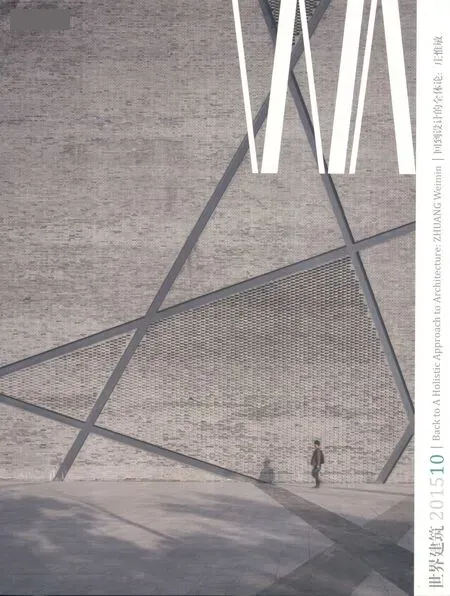2008北京奥运会射击馆,北京,中国
2008北京奥运会射击馆,北京,中国
Shooting Venue of 2008 Olympic Games, Beijing, China, 2008
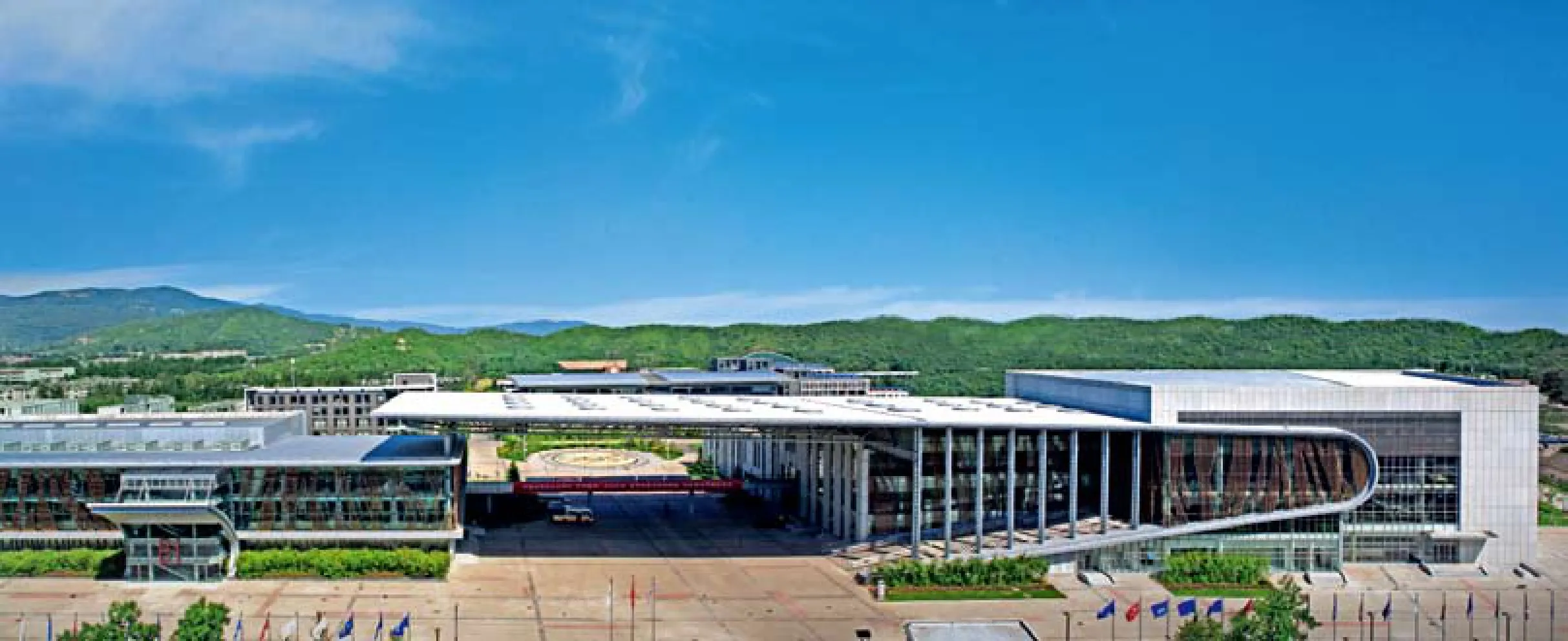
1 主入口鸟瞰/Bird's eye view of main entrance
射击运动是一项历史悠久的传统奥运项目,是化干戈为玉帛的奥林匹克精神的产物,有着不同于其他运动项目的独特文化。射击运动又是一项以静制动、以巧搏力的项目。射击运动源于森林狩猎,是一项非常贴近自然的运动项目。运动员在草地、蓝天和阳光下,追求精准,以静制动,进行耐力和心理素质的较量,使这项运动展现出人与自然的相融和谐,建筑与环境密不可分的相互依存关系。抛弃追求彰显“国家象征”的宏大叙事式的立面追求,强调建筑空间与自然的对话,体现回归自然、回归人性、回归建筑的本原,应该是本设计最本质的追求。
方案以“林中狩猎”为理念,更加强调建筑的人性化色彩,减少了建筑的刚性色彩,强调给人以温暖、舒适、亲切的感受。建筑外部形态构思延续林中狩猎的设计理念,在建筑形式上呼应原始狩猎工具——弓箭的抽象意向。资格赛馆与决赛馆之间的联系部分是整个射击中心园区的入口,建筑设计采用将屋面与入口台阶连成整体的处理手法,由此形成的折线弧形开口成为整个建筑群特征鲜明的母题,在资格赛馆水平延伸的形体断面以及5个主要观众出入口处重复呼应弧形母题。在二层、三层主要观众休息区域的幕墙外侧,采用铝型材热转印木纹肌理竖向遮阳百叶的处理,形成引发人们联想的抽象的森林意向。
在建筑功能布局上,需要为所有靶位创造尽可能均等的比赛条件。资格赛馆采取了4个靶场分两层竖向叠落的布置方式,一层为25m、50m两个半露天靶场,二层为10m靶、10m移动靶两个室内靶场。资格赛馆内部从北向南,分别设置靶场射击区、裁判区、观众坐席区、绿色中庭、观众厅等几个功能片段,比赛厅都按照相同的剖面功能关系,水平延伸这种布局关系,保证全部靶位的南北向、均好性。
建筑整体风格自外延续到室内,室内设计中将“质朴” “自然” “力量” “平静”等体现运动本质的元素加以发挥,凸显“质朴运动精神”“自然的回归”“内在力量的再现”的设计主题,呼应建筑“表现原始张力”的弧形语言,并加以强调,成为室内空间设计的控制元素。设计中尽量表现建筑结构自身的质感,对结构材料、构造做法进行真实的再现,强调还原材质自身的表现力,运用了诸如木材、清水混凝土、青石、木地板、卵石等多种自然材料,传达建筑由外到内统一的建筑语言和一致的建筑人文意境。
射击项目是一个管理非常特殊的项目,由于我国实行非常严格的枪支弹药管理制度,射击运动其实并不是一个大众普及运动。赛后利用这一建造体育场馆面临的共同难题,在这个场馆中变得更加具有不定性。整个项目的功能布局为赛后利用提供了充分的余地,赛后面向内部的射击训练设施都集中在北侧,为奥运会大量观众观赛设置的观众活动区都集中在面向城市道路的南侧,这样待奥运会比赛结束后,在保证北侧面向园区内部的训练功能不受影响的前提下,南侧面向外部的观众活动区可以进行面向社会的赛后改造利用,可以作为展示、商业、公共活动空间。资格赛馆与决赛馆中,固定座席和临时座席都被设计为完整的区域,当大型赛事结束后,钢结构的临时座席可以被整体拆除,从而获得完整的大空间,利于灵活改造利用。
回归本原的建筑理念定位,使我们在设计中不追求华丽的建筑表现,尽量避免单纯的建筑装饰,建筑从内到外的建筑材料、工艺都围绕基本功能要求展开,控制建筑造价,营造建筑朴素自然的形象。同时,将建筑经济性的考虑不仅放在建筑建造这个环节上,而在影响建筑长期使用的诸如建筑保温、采光、自然通风等方面,采用适宜技术手段和策略实现建筑长期运营中的节能和可持续发展。□
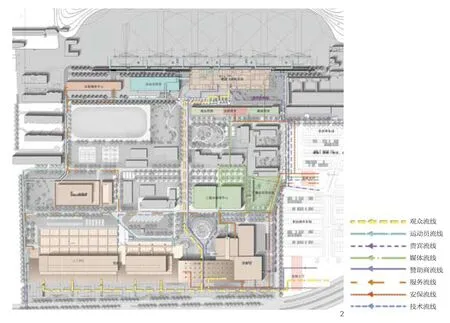
2 总平面/Site plan
项目信息/Credits and Data
项目负责人/Principal in Charge: 庄惟敏/ZHUANG Weimin
设计团队/Design Team: 庄惟敏,祁斌,汪曙等/ ZHUANG Weimin, QI Bin, WANG Shu, et al.
场地面积/Site Area: 64,500m2
总建筑面积/Total Floor Area: 47,626m2;
地上/Aboveground, 45,372m2;
地下/Underground, 2254m2
檐口高度/Height of Eaves:
资格赛馆/Qualification competition venue, 18m;
决赛馆/Final competition venue, 24m
建筑长度/Length: 260m(资格赛馆/Qualification competition venue)
座席数/Number of Seats:
资格赛馆/Qualification competition venue:6491个(固定座席/Fixed seats, 1024个;临时座席/Temporary seats, 5467个)
决赛馆/Final competition venue: 2493个
设计时间/Design Period: 2003
竣工时间/Completion: 2008
摄影/Photos: 张广源/ZHANG Guangyuan
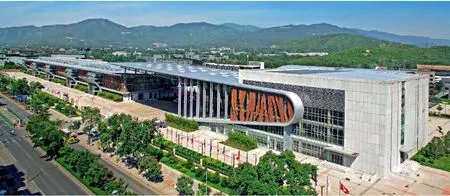
3 外景/Exterior view
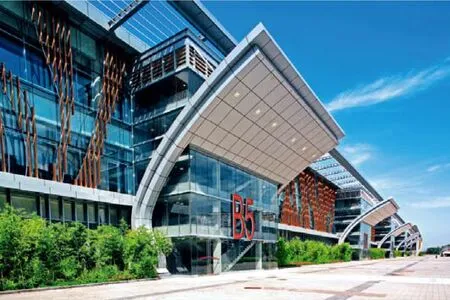
4 资格赛馆观众入口/Audience entrance of qualification competition venue
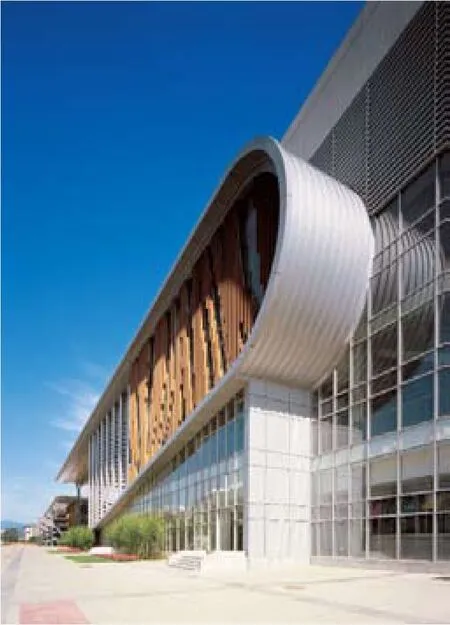
5 决赛馆局部/Part view of final competition venue
Shooting is an Olympic event with a timehonored history. Though it should embody the peaceful Olympic spirit, its culture differs from many others. In addition, shooting is a program that values individual skill over strength. As the event itself originates from hunting in the forest, it is closely related to nature. This pursuit of precision, endurance, and steadiness under the sun represents the harmony of man and nature, in a way that resembles the relationship between architecture and the environment. the essence of this proposal lies in this humanistic dialogue between spaces and nature, without over-emphasizing exaggerated formal narratives.
"Hunting in the forest" is the concept of this proposal, stressing humanism and a sense of warmth, comfort, and amenity rather than rigidity and solidity. The building form resembles a bow and arrow, a representation of hunting's primal tools. The connection between the qualification competition venue and the final competition venue also serves as the entrance to the center of the shooting zone. Using an arc as the visual theme of the building complex, the roof and the entrance steps are connected, and this motif is repeated in the cross section of the qualification competition, as well as in the five main audience entrances. A glass curtain wall fronting lounges on the second and third floor feature applied thermal transfer printing on the shades, this pattern relating to an abstract image of the forest.
The program requires equal conditions for all of the competitor positions. The qualification competition venue consists of a total of four ranges over two floors, the first floor with two semi-outdoor ranges of 25m and 50m, and the second floor with two indoor ranges of 10m and 10m with moving targets. Within the qualification competition venue the ranges, the referee zone, audience seats, the green atrium, and the audience hall are oriented north to south. These multiple competition areas feature a consistent horizontal extension of the section in order to make sure that each competitor position is equal.
The building's basic theme extends from the exterior to the interior. the interior design is rooted in the primal essence of competition, revealing motifs such as purity, nature, strength, and peace, so as to develop into several design themes including "the pristine sports spirit", "the return to nature", and "the representation of inner strength". These themes control the interior design itself, which is a response to and re-emphasis of the arc element the represents "primal force". this proposal made efforts to express the nature of the building's structure, revealing its materials and tectonics. the expressive power of raw materials such as wood, raw concrete, bluestone, wood flooring, and gravel are articulated. Such a configuration speaks of unity in architectural language as well as artistic imagery.
The management of the shooting programs is unique. Due to the strict control of firearms in China, shooting as a sport is quite difficult to popularize. The common challenge of post-game reuse becomes especially uncertain for this type of venue. As an solution, the program layout offers an abundance of space for post-game reuse. The inward-looking training facilities are concentrated to the northern side, while the public areas on the southern side reach out, ready for reconstruction and transformation into exhibition, commercial, activity spaces, and many other possibilities. Within the qualification competition venue and the final competition venue, both the fixed and temporary seats were created as a contiguous steel structure, so that they can be removed without much effort afterwards to make space for more flexible functions.
The basic theme of purity kept us from a pomposity in form and typical decorations. The materials and tectonics involved are all based on basic functionality in order to control the cost and to make a honest gesture. Meanwhile, the project's concern over economy is not only placed upon the single phase of construction, but also on the long term performance of insulation, lighting, ventilation, etc. Both technology and a design strategy contribute to the building's energy-saving and sustainability.□
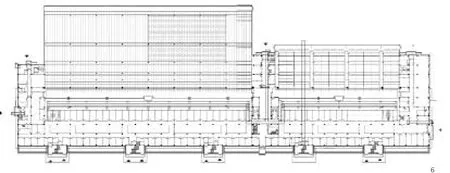
6 资格赛馆首层平面/Floor 0 plan, qualification competition venue
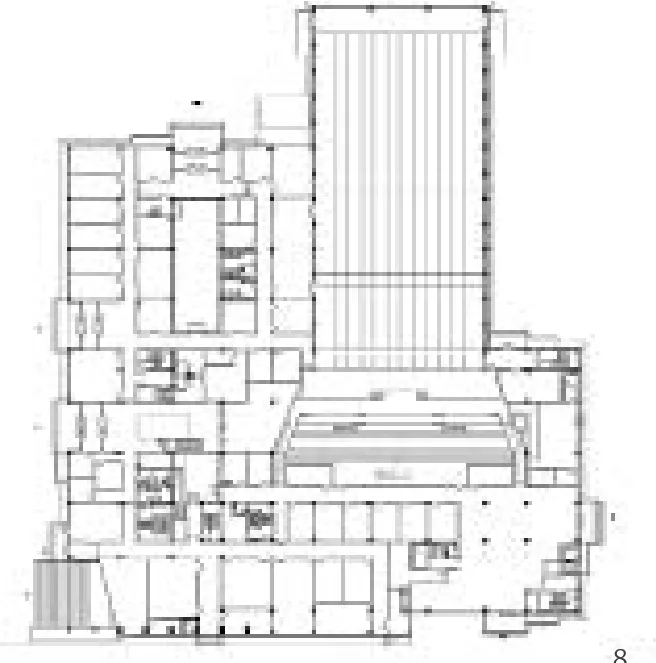
7 资格赛馆二层平面/Floor 1 plan, qualification competition venue
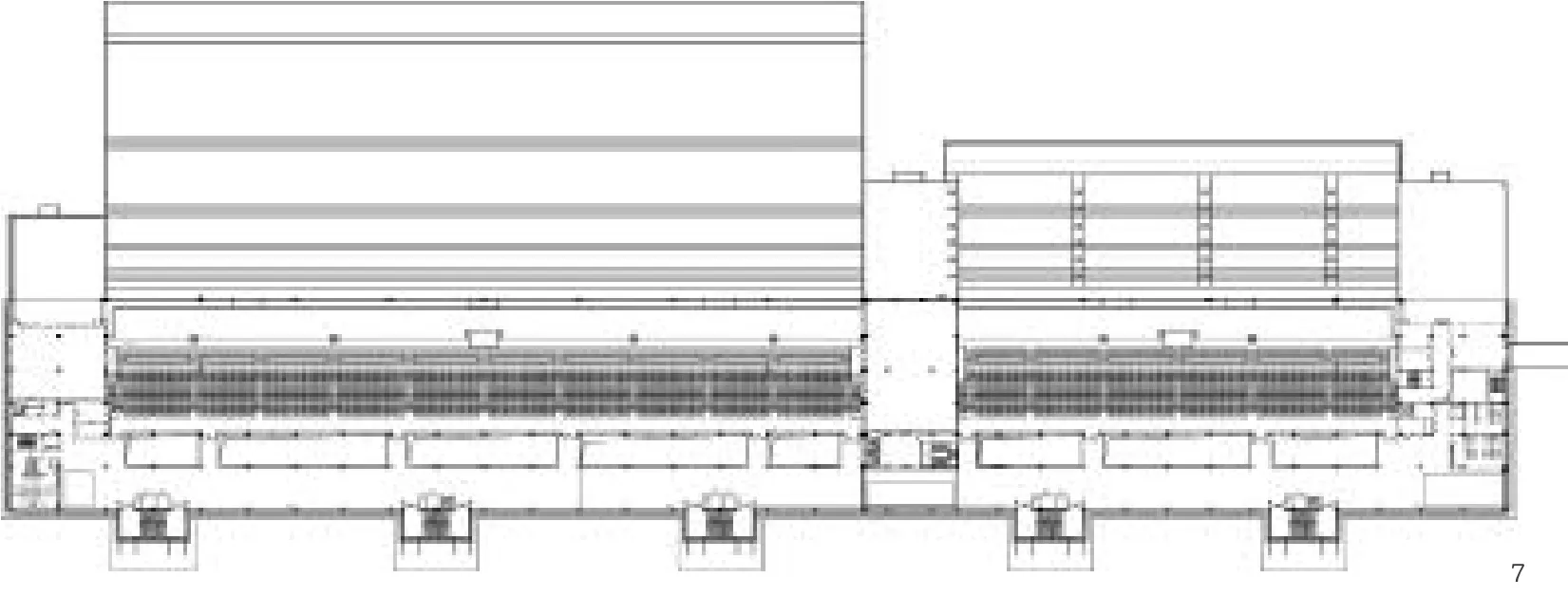
8 决赛馆首层平面/Floor 0 plan, final competition venue
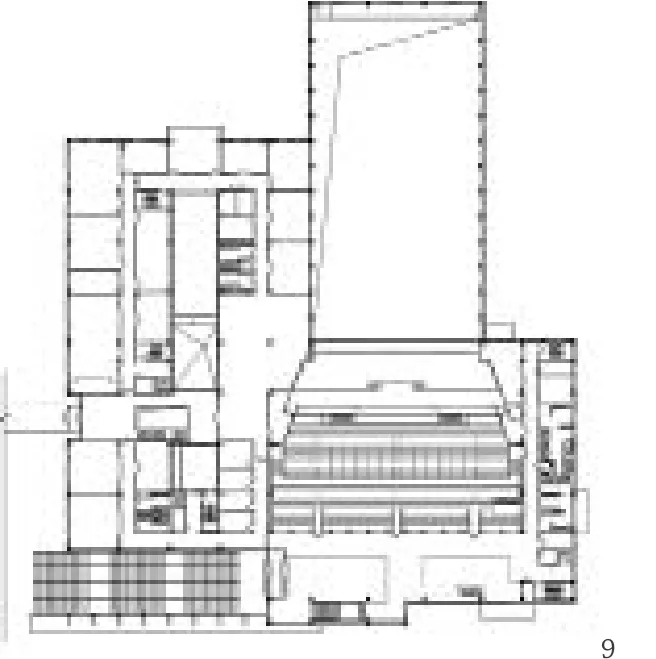
9 决赛馆二层平面/Floor 1 plan, final competition venue
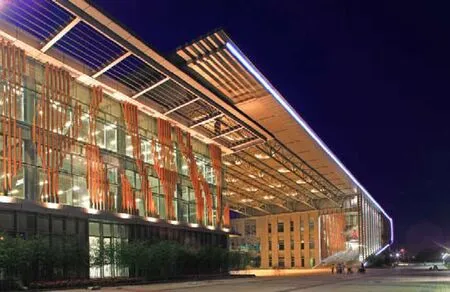
10 主入口广场南侧夜景/Night view of the south side of the main entrance
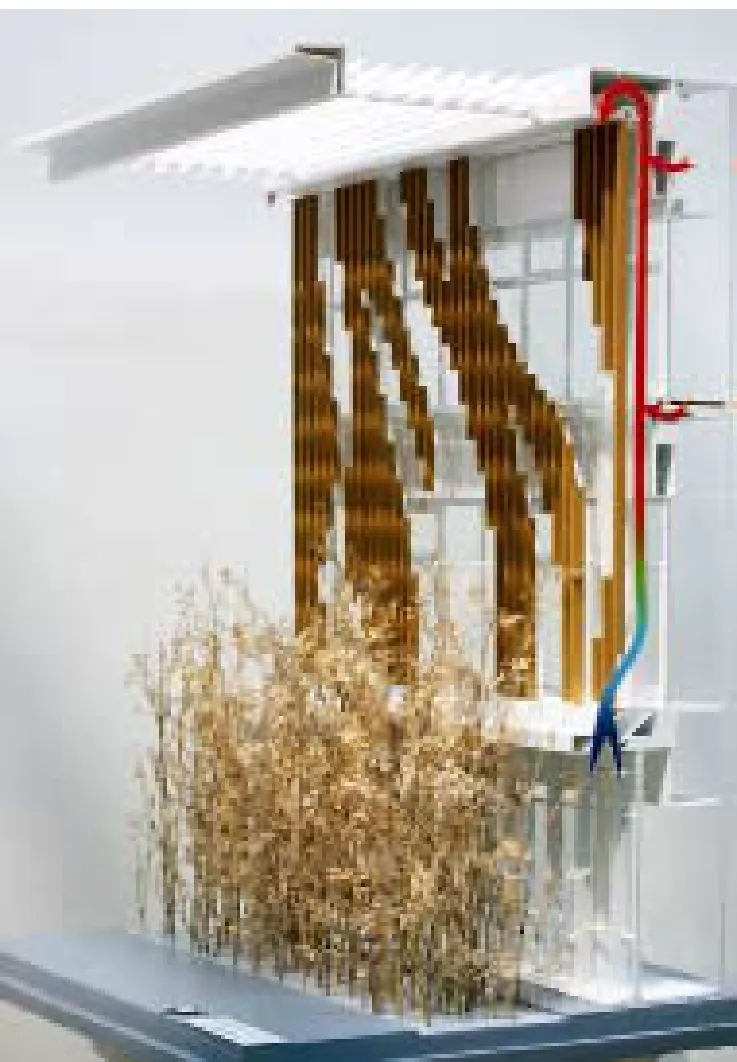
11 生态呼吸式遮阳幕墙细部模型/Model of the curtain wall
评论
李兴钢:奥运射击馆最大的特点是在紧张的用地和有限的造价条件下,将诸多比赛观赛的功能需求和流线安排得井井有条,采用独特的双层赛场和双层幕墙设计,采光照明设计突出了对运动员比赛条件的重视,经济、节地、节能,建筑效用良好;后奥运场馆利用策划和设计中,考虑到射击运动的特殊性,在确保赛后专业及训练比赛功能之外,又为多种公众活动预留了空间,以实现可持续的长期运营。射击单元的分段排列设置及对应的多个观众入口设计,弱化了建筑的超长体量,强化了节奏和构成感;体现在建筑外观的“森林狩猎”——作为对射击运动的象征性阐释,虽略显牵强,但最大的意义是回避了宏大沉重的国家象征性表达,使得整个建筑呈现出放松而轻盈愉悦的气质,恰恰体现了这一运动本应带给观众和运动员的精神特征。
Comments
LI Xinggang: The main feature of the Beijing Olympic Shooting Venue is to meet functional requirements of games and game watching within a limited site and a tight budget. All sorts of circulation is arranged in perfect order. the uniqueness lies in the two-story shooting gallery as well as the double-skin curtain wall. the lighting design shows the designer's concern for a better game environment. the building is designed to be highly efficient, and it is economical, land-saving and energy-saving. As for the Post-Olympic usage, a long term sustainable operation is highlighted. It is realized that shooting is a special sport with few players, so that a variety of space are reserved for public events, which is a bonus beyond the training and game facilities maintained for professionals. The sectioned shooting units and its corresponding spectator entrances have visually shortened the mass of the extra-long hall, meanwhile enhanced the sense of rhythm and composition. It is said that the exterior design of the Beijing Olympic Shooting Venue was inspired by jungle hunting. Although this might be a bit farfetched, at least it chose an approach of more casual and cheerful to break the routine of national building design in China which was usually grand and solemn to symbolize the nation . What's more, it is the approach to bring athletes and the public the spirit of shooting as a sport. (English translation by Dandan WANG)

12 资格赛馆剖面图/Section, qualification competition venue
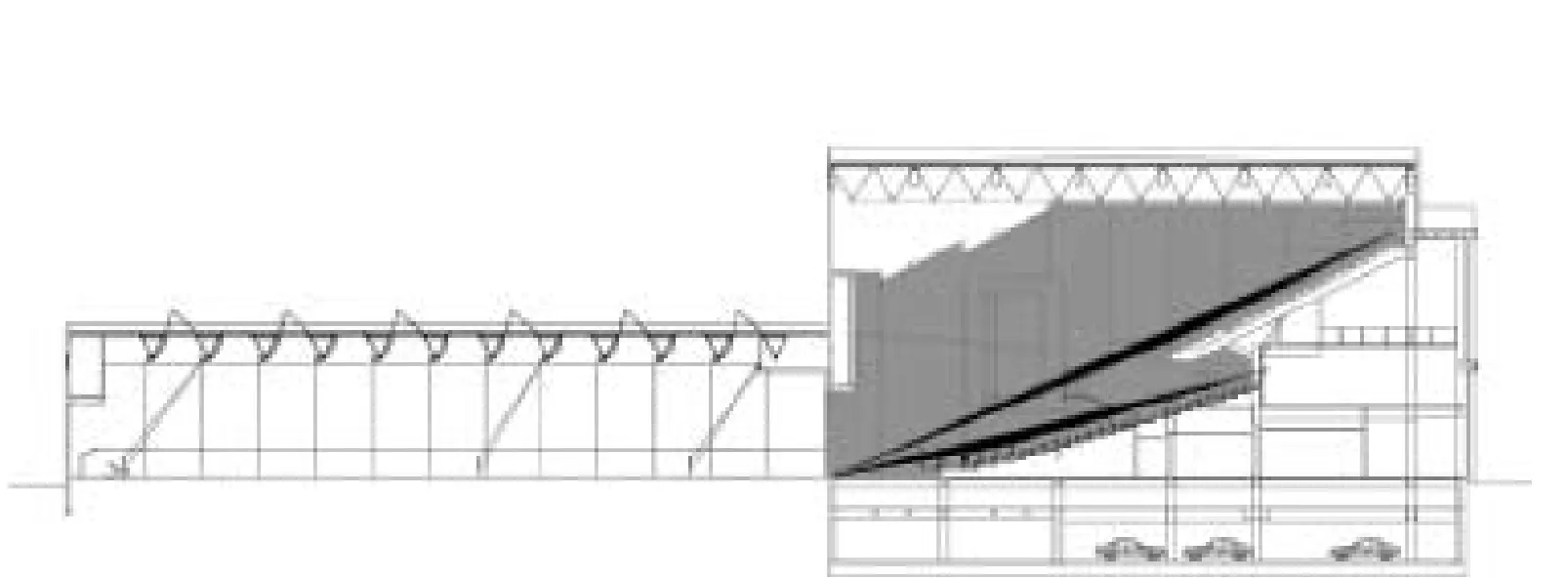
13 决赛馆剖面图/Section, final competition venue
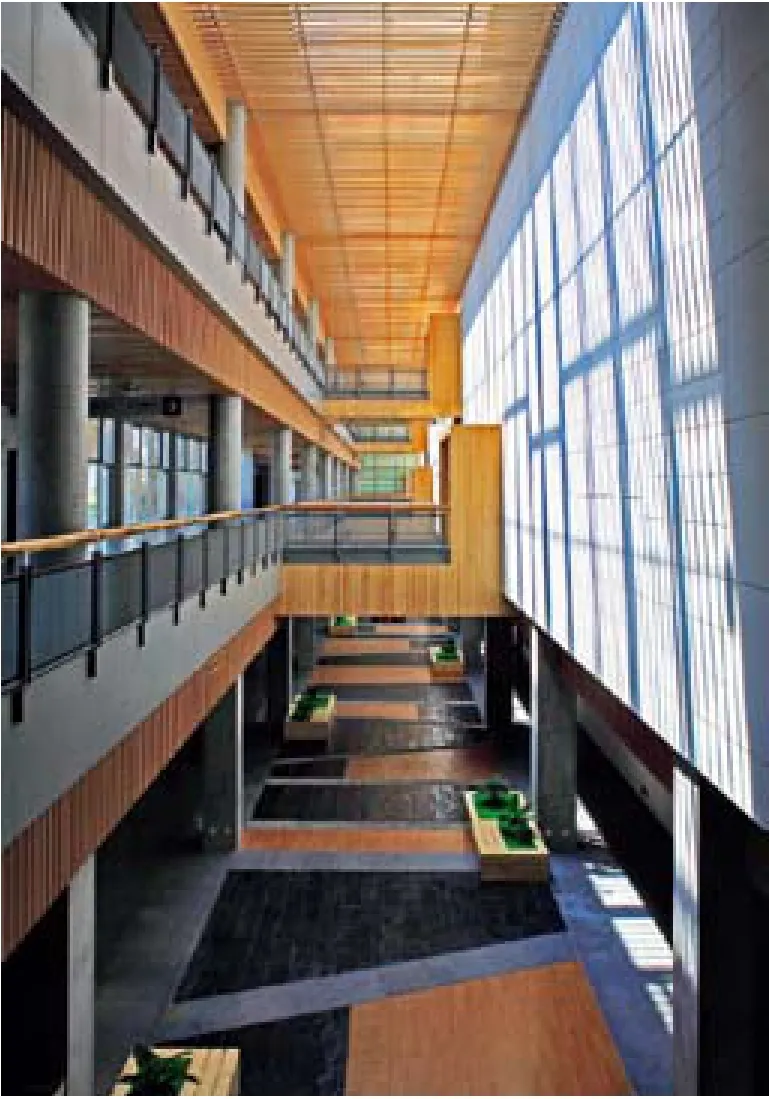
14 资格赛共享休息区/Lobby of qualification competition venue
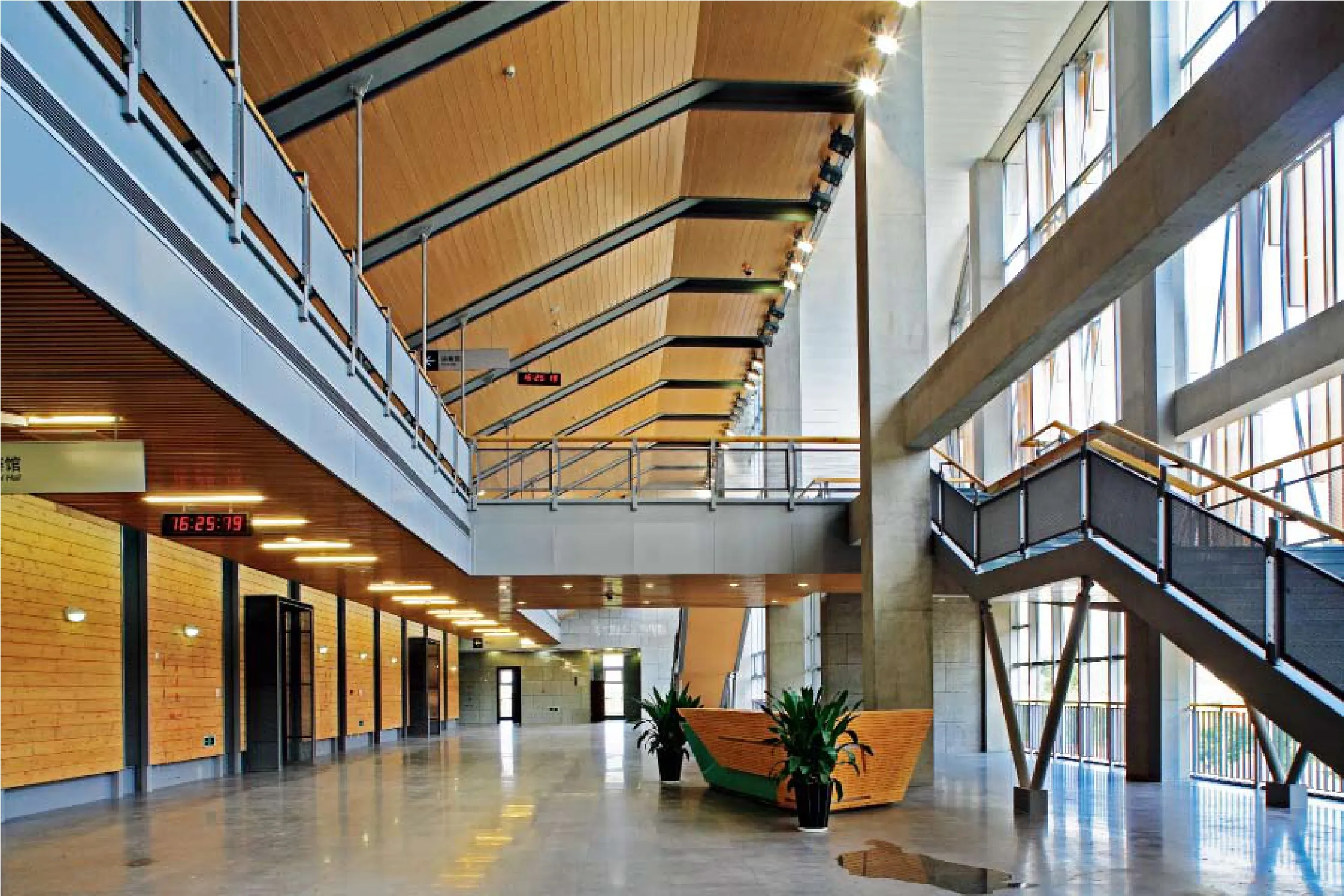
15 决赛馆观众休息厅/Lobby of final competition venue
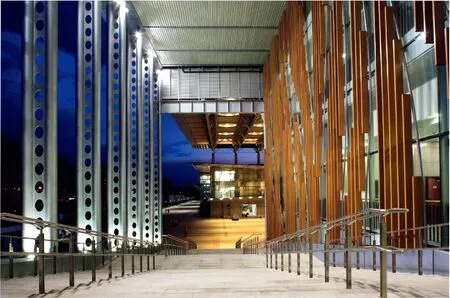
16 从决赛馆主入口看资格赛馆夜景/Night view from the main entrance of final competition venue to qualification competition venue

